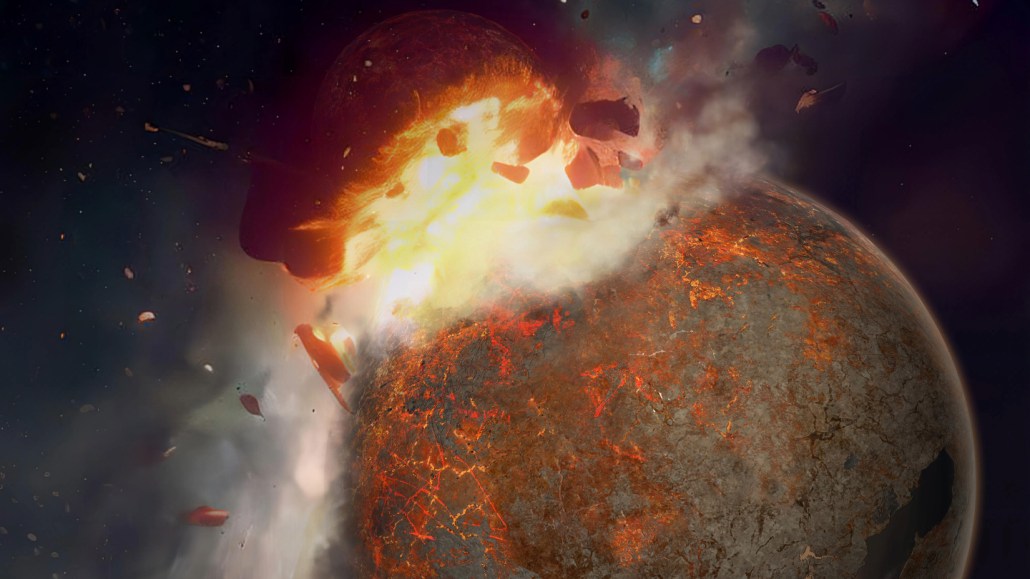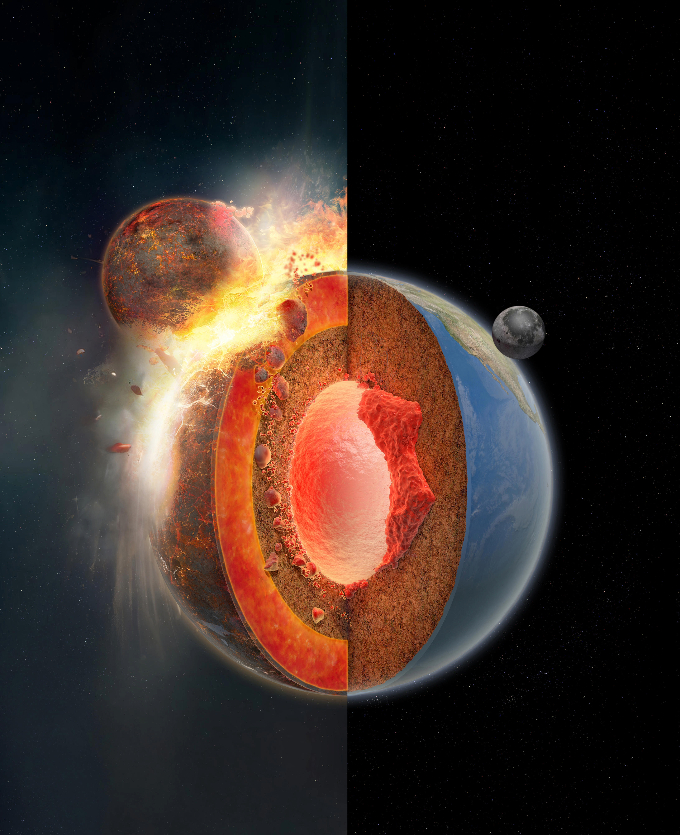Rock from the impact that formed the moon may linger in Earth’s mantle
Strangely dense rock in the mantle is from an impact 4.5 billion years ago, researchers say

Continent-sized zones of dense rock — leftovers from the cosmic collision (illustrated) that formed the moon — sit atop Earth’s core, a study finds.
Hernán Cañellas
About 4.5 billion years ago, a Mars-sized object smashed into the young Earth, spraying debris that coalesced to form the moon, many scientists think. Some remnants of that object, called Theia, exist today as large amounts of dense material sitting atop Earth’s core, researchers propose November 1 in Nature.
In recent years, geophysicists have discovered continent-sized zones of rock at the base of Earth’s mantle where seismic waves travel abnormally slowly, suggesting the rock there is denser than the rest of the mantle rock. One of these blobs, known as large low-velocity provinces, lies beneath Africa. The other lies half a world away beneath the Pacific Ocean, says Qian Yuan, a planetary geodynamicist at Caltech.
Some researchers have suggested these masses are the remnants of tectonic plates that were shoved beneath others and then sunk down to the boundary between Earth’s outer core and the overlying mantle. But Yuan and his colleagues offer a different origin story.
The moon is only about 2 percent the mass of Earth, which leaves a substantial amount of Theia unaccounted for. So, using supercomputer simulations, the researchers tracked the fallout from a smashup between the nascent Earth and another object about 10 percent as massive.
In the simulations, each body before the collision had a dense iron core swaddled by a mantle of lighter rocks. Each object was digitally subdivided into particles about 10 kilometers across, so that the postimpact fragments could be tracked, says study coauthor Vincent Eke, a computational physicist at Durham University in England. In all, the team’s simulations tracked about 100 million particles, he notes.
The simulations suggest that a large part of Theia’s core — equivalent to about 3 percent of Earth’s mass today — was left on our planet. Soon after the collision, that dense molten material would have sunk to join Earth’s core. Meanwhile, a large volume of Theia’s mantle, up to 5 percent of Earth’s mass, was embedded in the uppermost 1,400 kilometers or so of Earth’s mantle, the study finds.

Moon rocks suggest that Theia’s mantle contained higher proportions of iron oxide minerals. That means it was probably a few percent denser than Earth’s mantle, Yuan says. Over the few tens of millions of years that followed the collision, that denser-than-average material slowly sank to accumulate and form the large low-velocity provinces, the researchers suggest.
Although many researchers have suggested that these low-velocity provinces are the remnants of tectonic plates, others have proposed that they’re high-density remnants of Earth’s original magma ocean that sank to the lowermost levels of Earth’s mantle. Attributing them to material left in the wake of the collision between Theia and the nascent Earth “is a new idea, I think,” says Paul Tackley, a geodynamicist at ETH Zurich who was not part of the new study.
Whether or not a run-in with Theia is what created the low-velocity provinces, it’s at least plausible that they’ve lasted the nearly 4.5 billion years since the moon’s formation, Tackley says. If the materials in those zones are dense enough to resist mixing with the overlying mantle as it slowly flows across them, he says, “they can survive over geological time.”
Known as the “giant impact hypothesis,” a collision between Earth and a protoplanet remains the leading theory of how the moon formed. Previously, researchers have suggested that such a collision would help explain the slight chemical differences between moon rocks and Earth’s (SN: 6/5/14). And scientists recently proposed that a collision between the nascent Earth and Theia, besides creating our planet’s moon, also may have jump-started plate tectonics (SN: 3/15/23).